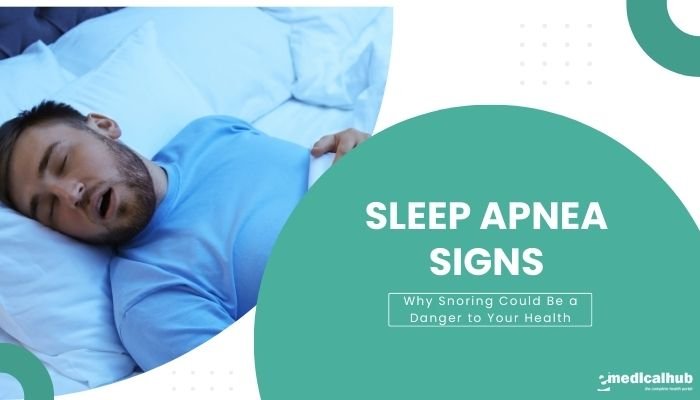Introduction
Snoring is often taken lightly, even jokingly, as the familiar nighttime disruption emanating from a spouse, parent, or roommate.
Yet not all snoring is benign. In some cases, consistent or loud snoring can be an early warning sign of sleep apnea, a disorder in which breathing is repeatedly interrupted during sleep. Left untreated, sleep apnea can contribute to serious health issues like hypertension, heart disease, stroke, and even accidents due to daytime drowsiness.
Understanding the difference between harmless snoring and potential indicators of a deeper problem is essential for everyone, particularly those prone to daytime fatigue or co-occurring conditions like obesity, type 2 diabetes, or cardiovascular disease.
This article unravels the basics of sleep apnea—its subtypes, how snoring fits into the picture, the broader health impacts—and lays out the steps for proper diagnosis and treatment. By recognizing that persistent snoring can be more than a bedtime annoyance, we empower ourselves or our loved ones to seek early intervention and thereby improve overall well-being.
Understanding Sleep Apnea
Definition and Types
- Obstructive Sleep Apnea (OSA): The most common form, caused by the relaxation of throat muscles or tissues that block the airway. During these blockages, breathing pauses (apneas) occur, often followed by a gasp or snort as the body forces the airway open again.
- Central Sleep Apnea (CSA): The issue lies in the brain’s signaling, where the brain briefly stops sending signals to the muscles controlling breathing. Less prevalent, CSA can overlap with conditions such as congestive heart failure or neurological disorders.
- Mixed/Complex: A combination of obstructive and central patterns is sometimes observed in certainpatients, further complicating diagnosis.
Prevalence and Consequences
- Significant Occurrence: According to multiple health agencies, millions of adults (and children) worldwide have sleep apnea, though many remain undiagnosed. It is more prevalent among men but frequently underrecognized in women.
- Health Burden: The cyclical drops in oxygen not only disrupt sleep but also strain the cardiovascular system and disrupt metabolic processes. Chronic, untreated sleep apnea can double or triple the risk of accidents, hamper job performance, and erode quality of life.
Mechanics of Snoring vs. Apnea
- Snoring: Air passing through a narrowed airway (often due to relaxed tissues in the throat) causes vibrations. Light, infrequent snoring can be normal.
- Apneas and Hypopneas: In sleep apnea, snoring is sometimes the prelude to partial or complete airway closure, leading to significantly reduced (hypopnea) or ceased (apnea) airflow. This triggers micro-arousals as the body fights to resume breathing, resulting in broken, unrestful sleep.
Key Takeaway: While not all snoring indicates sleep apnea, frequent, loud snoring can be a hallmark of obstructive events. Observing one’s symptom pattern is often the first step in identifying OSA.
Why Snoring Could Be a Warning Sign
Snoring in Obstructive Sleep Apnea
- Consistency: People with OSA often snore loudly and regularly, sometimes described as “chainsaw-like” or disruptive even across rooms.
- Pattern: Family members might notice abrupt silences (breathing pauses) followed by choking or gasping that restarts snoring—an alarm flag for OSA.
Occasional vs. Problematic Snoring
- Positional Snoring: Some individuals only snore when lying on their back, not a definitive sign of OSA but still can link to partial airway obstruction.
- Frequency and Intensity: Snoring that intensifies over time, or occurs nightly, or is accompanied by daytime fatigue, is more suspect for underlying sleep apnea.
- Observing Changes: Gaining weight, new nasal congestion, or alcohol use can aggravate snoring—these factors can push borderline snorers into OSA territory.
Daytime Indicators
- Excessive Sleepiness: Many OSA patients rarely achieve deep rest, so they struggle with morning headaches, midday drowsiness, or nodding off during inactivity.
- Mood Swings and Irritability: Chronic poor sleep can hamper emotional regulation, leading to frustration or depression.
- Partner’s Perspective: Sleep partners often sense restlessness or abrupt wake-ups in the snorer, noting that each time snoring stops, the chest might still be heaving with no air movement.
Crucial: Chronic, loud snoring plus pronounced daytime tiredness is a strong predictor of possible sleep apnea. A formal sleep evaluation is recommended in such cases.
Risk Factors for Sleep Apnea
Physical and Anatomical
- Obesity: Excess weight, particularly around the neck, promotes airway narrowing. Neck circumference >17 inches in men, >16 inches in women indicates elevated OSA risk.
- Craniofacial Anatomy: A recessed chin, narrow throat, or enlarged tonsils can predispose to airflow blockage.
- Nasal Congestion: Chronic sinus issues or deviated septum hamper easy breathing, fueling mouth breathing and potential snoring.
Lifestyle Factors
- Alcohol and Sedatives: Drinking or certain medications relax throat muscles, making snoring and apneas more likely.
- Smoking: Irritates airway tissues, leading to swelling, which narrows the airway.
- Physical Inactivity: Contributes to weight gain, compounding OSA risk.
Medical Conditions
- Hypertension: Repeated studies show strong overlap between high blood pressure and OSA.
- Type 2 Diabetes: Insulin resistance correlates with systemic inflammation and sleep apnea.
- Hypothyroidism: Tends to cause mucopolysaccharide deposits in tissues that can reduce airway patency.
Demographic Trends
- Age: While it can develop at any age, middle-aged or older adults see increased incidence.
- Gender: Historically more common in men, though post-menopausal women approach similar rates. Women’s presentations can be subtler.
- Family History: Genetics can influence craniofacial structure and predisposition to weight gain, thus raising OSA risk.
Health Consequences of Untreated Sleep Apnea
Cardiovascular Strain
- Elevated Blood Pressure: Surges in adrenaline from repeated arousals trigger or worsen hypertension.
- Heart Disease and Stroke: Chronic oxygen drops and surges in sympathetic drive can accelerate atherosclerosis or arrhythmias, raising stroke, heart attack, and heart failure risk.
- Atrial Fibrillation: Sleep apnea is recognized as a notable contributor to this irregular heart rhythm.
Metabolic Disturbances
- Impaired Glucose Tolerance: Sleep fragmentation fosters insulin resistance, facilitating or worsening diabetes.
- Weight Gain Cycle: Fatigue from poor sleep reduces energy for exercise, while hormone imbalances (ghrelin/leptin) can encourage overeating.
Cognitive and Psychological Impact
- Memory and Concentration: Repeated micro-arousals degrade REM sleep crucial for memory consolidation.
- Mood Disorders: Associations with depression, anxiety, or irritability are well-documented.
- Accident Risk: Daytime drowsiness can jeopardize job performance or safety, e.g., automobile accidents.
Reduced Quality of Life
- Chronic Fatigue: Ongoing tiredness erodes engagement in social, recreational, or professional pursuits.
- Relationship Strain: Loud snoring can push sleeping partners to separate rooms, fueling tension or emotional distance.
Diagnosis of Sleep Apnea
Warning Signs to Seek Evaluation
- Frequent Nighttime Awakenings: Waking to gasp for air, persistent dryness in the mouth, or choking episodes.
- Morning Headaches: Possibly from nocturnal CO₂ retention.
- Partner Observations: If a partner witnesses repeated breath-holding or extreme snoring, that’s a strong impetus to investigate.
Sleep Study Techniques
- Polysomnography (PSG): In-lab overnight study measuring brain waves, oxygen levels, heart rate, breathing patterns, and leg movements.
- Home Sleep Apnea Testing (HSAT): For moderate or straightforward suspected OSA, simpler devices can measure airflow, respiratory effort, and oxygen saturation at home.
- Diagnostic Indices: The Apnea-Hypopnea Index (AHI) quantifies average episodes per hour, grading mild, moderate, or severe OSA.
Medical Specialist Consultation
- Sleep Medicine Specialists: Pulmonologists, ENT surgeons, or neurologists sometimes focus on diagnosing and treating OSA.
- Follow-Up: Additional ENT evaluations if structural nasal or throat blockages are suspected.
Treatment and Management Strategies
Lifestyle Modifications
- Weight Reduction: Even 5–10% weight loss can meaningfully ease OSA severity.
- Exercise: Improves cardiovascular health, can help with mild OSA, though advanced OSA typically requires more direct interventions.
- Sleep Hygiene: Regular bedtime, controlling alcohol or sedatives near sleep, avoiding sleeping supine if possible.
Medical Devices
- CPAP (Continuous Positive Airway Pressure)
- Most Common: Delivers a steady flow of air through a mask to keep the airway open.
- Effectiveness: Considered the gold standard for moderate to severe OSA.
- Challenges: Adherence can be tricky due to mask discomfort, dryness. Adjustments or different mask styles often solve these issues.
- Oral Appliances
- Mandibular Advancement Devices: Pull the lower jaw forward, expanding airway space for milder or moderate OSA.
- Pros: Easier to travel with or for people intolerant to CPAP. Some report jaw or teeth discomfort.
Surgical Approaches
- UPPP (Uvulopalatopharyngoplasty): Tissue removal from the soft palate and uvula to widen airway. Variable success rates.
- Nasal Septum Correction: If a deviated septum or nasal polyps contribute significantly, rhinologic surgeries might help.
- Implants or Hypoglossal Nerve Stimulation: Implanted devices that stimulate the tongue muscle to keep the airway open. Usually for patients who fail CPAP or cannot tolerate it.
Additional Therapies
- Positional Therapy: Encouraging side-sleeping with special pillows or wearing a device preventing supine posture.
- Treating Concomitant Issues: Allergies, GERD, or hypothyroidism, which can exacerbate OSA.
- Follow-Up Polysomnography: Evaluate therapy efficacy, refine prescriptions or mask settings.
Prevention Tactics and Personal Tips
Healthy Lifestyle as a Foundation
- Sensible Diet: Minimizing processed sugars or high-saturated-fat foods aids weight control.
- Moderate Alcohol: Reducing or avoiding it near bedtime helps keep throat muscles from over-relaxing.
- Limit Sedatives: If possible, examine if sleeping pills are necessary or if alternative strategies might suffice.
Environmental Adjustments
- Bedroom Setup: Ensure nasal patency by controlling allergens, using humidifiers if dryness is an issue.
- Elevated Head Position: Slightly raising the bed head might reduce mild snoring or reflux.
- Consistent Sleep Schedule: Maintaining stable circadian rhythms fosters better sleep architecture.
Identifying Early Red Flags
- Annual Checkups: If overweight or have co-morbid conditions, discuss potential OSA with your doctor.
- Partner Input: If a partner frequently complains of your loud snoring or notices breathing pauses, prioritize seeking a sleep study.
Overcoming Stigma and Promoting Awareness
Breaking Misconceptions
- Snoring Is Not Always “Harmless”: Some individuals trivialize snoring, missing the serious medical implications.
- CPAP Myths: Some fear CPAP machines as cumbersome; modern devices are quieter, smaller, and user-friendly with extensive mask options.
Encouraging Screening
- Physicians’ Role: Primary care providers should actively inquire about sleep quality and potential OSA risk factors.
- Community Outreach: Education at community centers, workplaces, or schools about OSA can reduce underdiagnosis.
Helping Loved Ones
- Support: Encouraging family or friends to get tested if signs are present, offering acceptance of CPAP usage.
- Understanding: Sleep apnea can be physically and emotionally draining—lifestyle changes are tough but can transform health.
Evolving Research and Future Directions
Technological Advances
- Wearable Devices: Some track oxygen saturation or movement, possibly hinting at OSA episodes, though validation is ongoing.
- AI in Sleep Medicine: Automated software analyzing polysomnogram data for more precise diagnoses.
- Better CPAP Comfort: Design innovations for quieter, more adaptive devices.
Precision Medicine for OSA
- Phenotyping: Not all OSA is identical; focusing on anatomical vs. non-anatomical traits can refine therapy, e.g., oropharyngeal exercises for certain patients.
- Drug Trials: Investigating sedation-based meds that maintain muscle tone or reduce apnea severity is an emerging area.
Integrative Models
- Comprehensive Approach: Combining weight management, addressing mental health, controlling metabolic comorbidities, and using advanced devices for robust, personalized care.
- Global Health Initiatives: With OSA rising in parallel with obesity epidemics, global bodies may push public health messaging akin to campaigns for hypertension or diabetes.
Conclusion
Snoring is often the butt of jokes, but in many individuals, it’s more than just noisy breathing—it signals a possible red flag for sleep apnea. Chronic partial or total airway obstruction can starve the body of oxygen, degrade sleep quality, and eventually lead to severe ailments like heart disease or stroke. While mild, occasional snoring doesn’t necessarily equate to OSA, persistent, loud snoring accompanied by daytime drowsiness demands serious consideration.
Fortunately, multiple solutions exist: from lifestyle changes and weight loss to CPAP therapy, oral appliances, or surgery. Even small interventions—like adjusting sleeping position, limiting alcohol, or effectively treating nasal congestion—might drastically reduce snoring episodes. Critically, raising awareness among the general public and within medical practice is crucial to identify, diagnose, and treat sleep apnea early. Living with OSA or loud snoring no longer needs to be an invisible burden. With proper screening, supportive therapy, and consistent follow-up, individuals can restore restful sleep and greatly diminish the health risks tied to this under-recognized condition.
Frequently Asked Questions (FAQ)
- Does everyone who snores have sleep apnea?
- Not always. Many snore with no major health threat. However, loud, habitual snoring plus daytime tiredness or witnessed apneas strongly suggest OSA. A sleep study can confirm
- Can children develop OSA from snoring?
- Yes, especially if enlarged tonsils/adenoids or obesity is present. Kids with OSA often show hyperactivity or academic difficulties from poor sleep. An ENT evaluation is recommended.
- What if I feel claustrophobic using CPAP?
- Modern CPAP devices provide varied mask options (nasal pillows, full-face, etc.). A respiratory therapist or sleep tech can help find a more comfortable fit or ramp features.
- Will losing weight guarantee snoring stops?
- Weight loss can significantly reduce OSA severity in overweight individuals, but anatomical factors or genetics might still cause some snoring or mild apnea.
- Is it possible to have OSA without snoring?
- It’s uncommon but feasible, especially in central sleep apnea or mild OSA. Snoring is typical for obstructive events but not an absolute requirement.
- How does drinking alcohol close to bedtime affect OSA?
- Alcohol relaxes throat muscles, intensifying airway collapse and lengthening apnea episodes, thus worsening OSA severity.
- Are there at-home remedies for mild snoring?
- Yes. Weight management, sleeping on one’s side, using nasal strips or saline rinses for congestion, and limiting alcohol near bedtime can help mild snoring. But if daytime fatigue persists, a professional evaluation remains critical.
References
- Peppard PE, Young T, et al. Increased prevalence of sleep-disordered breathing in adults. Am J Epidemiol. 2013;177(9):1006-1014.
- Benjafield AV, et al. Estimation of the global prevalence and burden of obstructive sleep apnea: a literature-based analysis. Lancet Respir Med. 2019;7(8):687-698.
- Punjabi NM. The epidemiology of adult obstructive sleep apnea. Proc Am Thorac Soc. 2008;5(2):136-143.
- Heinzer R, Vat S, Marques-Vidal P, et al. Prevalence of sleep-disordered breathing in the general population: The HypnoLaus study. Lancet Respir Med. 2015;3(4):310-318.
- Sateia MJ. International classification of sleep disorders. Chest. 2014;146(5):1387-1394.
- Kapur VK, et al. Clinical practice guideline for diagnostic testing for adult obstructive sleep apnea. J Clin Sleep Med. 2017;13(3):479-504.
- Marin JM, et al. Long-term cardiovascular outcomes in men with OSA-hypopnea syndrome. Lancet. 2005;365(9464):1046-1053.
- Eckert DJ, Malhotra A. Pathophysiology of adult obstructive sleep apnea. Proc Am Thorac Soc. 2008;5(2):144-153.
- Raschke F, Shamsuzzaman ASM. Consequences of untreated OSA in patients with preexisting cardiovascular disease. Curr Cardiol Rep. 2018;20(8):62.
- Grimaldi D, et al. The impact of sleep disorders on glucose metabolism: Endocrine and metabolic consequences. J Endocrinol Invest. 2020;43(4):555-563.
- Masa JF, et al. Efficacy of different CPAP modalities in OSA. Lancet Respir Med. 2019;7(5):388-390.
- Randerath W, Verbraecken J, Andreas S, et al. Definition, discrimination, diagnosis and treatment of central breathing disturbances during sleep. Eur Respir J. 2017;49(1):1600959.
- American Academy of Sleep Medicine. Clinical practice guideline for the treatment of OSA with positive airway pressure therapy. J Clin Sleep Med. 2019;15(3):335-343.
- Friedman M, et al. Surgical treatments for obstructive sleep apnea. Otolaryngol Clin North Am. 2016;49(6):1373-1381.




